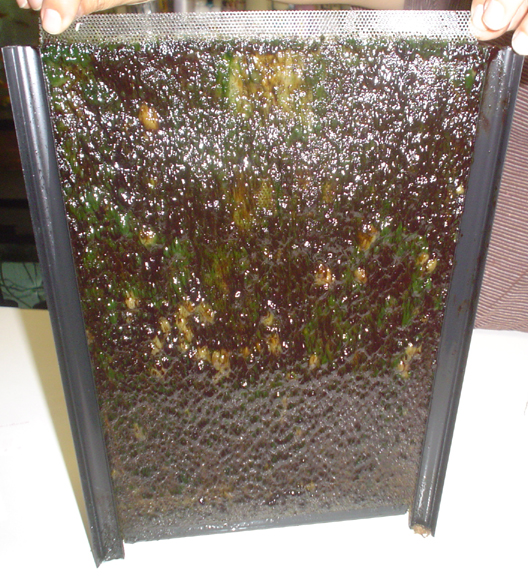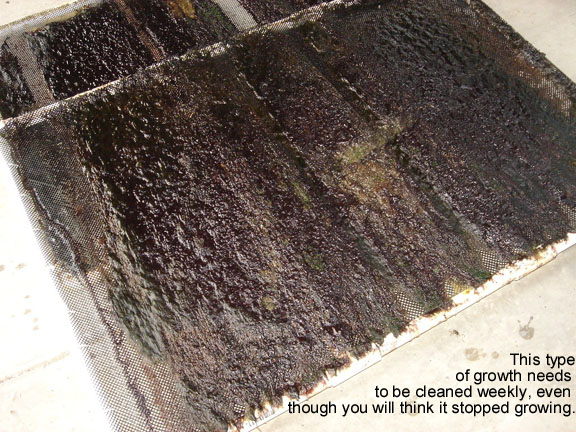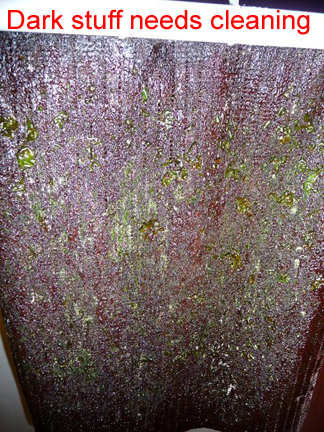Successes of the Day:
todj2002 on the SWF site: "since installing scrubber, N and P are still both at zero. i cleaned it again today. not any big deal, but huge progress for me. finally beat the algae after two years of trying. using scrubber with chaeto and RO water now. finally getting somewhere."
Marine_Nick on the RP site: "Thought I'd update on my screen. When setting it up I was concerned about light pollution from the sump into the room, and noise from the falling water. as my tank is on an outside wall, I wanted to put the screen outside if possible. I already had an old 18 x 12 x 12 tank, so had it drilled and put a small wier in it, the water is pumped from the sump up and out through the wall to the screen, runs down the screen, through the weir, back through the wall and back into the sump. All of this is in a small shed I made which contains all the lighting etc, my screen is 18 inches tall by 12 inches wide and has a light on either side. Screen has been running now for 4 weeks, and my nitrates have dropped from 30 to 7 and phosphate from 0.25 to 0. In the last 4 weeks, nothing else has changed in my tank other than more fish being introduced, and therefore more food being added, and still the parameters have dropped!! Overall I'm really happy with results so far and hope to see the nitrates drop to zero in the next week or two. Big thanks to Santa Monica for this thread and all the info!"
jtrembley on the MD site: "I got frustrated with the skimmer (EuroReef, rated for 80) on my 40 gallon a while back. It was pulling out *lots* of crud, but I was having trouble with detritus building up, and rising P values. Since yanking the skimmer and DIYing (poorly) a rev. 2 scrubber [acrylic box style], phosphates and nuisance algae are down, and the backlog of detritus is slowly being consumed. I'm seeing lots more worms (particularly the small ones that build white, spiraling tubes) and 'pods (amphi- and cope- that is, but not octo-). Here's the funny thing: at the 3 year stage of my 40, I started getting lots of nuisance algae, despite having one of the hands-down best skimmers for small tanks, an MCE600, on it. Thinking that I was doing something wrong, I put an MC-80 on it. After another year, I started getting more and more detritus building up in the display, despite having a *lot* (over 2k GPH) of flow. And then I noticed something else: I no longer had many fan and bristle worms, amphipods, or copepods left in the sytem, either. So...I started swapping out my old LR for new, to replenish the critters. And I tried Fauna Marin and vodka dosing. But the critters weren't really spreading, and the nuisance algae was getting worse, and my P was rising despite water changes. So, I thought about it, poked around, and looked at Eric Borneman's study of *fresh* skimmate (i.e., not stuff that was left in the cup to rot). And I realized something: having a high quality skimmer on the tank was probably stripping the tank of big chunks of its potential cleanup crew. So I took off the skimmer, and put in a turf screen to cover the water's surface in what used to be the skimmer's chamber in my sump. Low and behold: I'm feeding more; I'm once again seeing fresh worm tracks in my sand bed; the copepods are back; the nuisance algae is dying off; P is undetectable by hobby kits; and the detritus is slowly clearing up. And I'm not doing as many water changes. I checked pH this morning, it was 8.2, before the lights are on. I'm honestly not seeing the down side. So yeah, removing the skimmer and putting in a $5 turf scrubber fixed my tank of "old tank syndrome". Just for giggles, I just tested my N (0.2 or 0.5 Salifert) and P (0.05 Hanna photometer). No visible HA, turfs, or cyano in the display, and I can (easily) feed 2X cubes of Hikari mysis, some dulse, and 2 scoops' worth of Reef Chili daily (again, in a 40). And I haven't done a water change in a month. I'm honestly not seeing a downside to scrubbers at this point."



